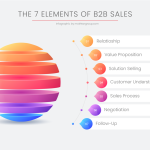Success isn’t just about persuasion or charisma—it’s about leveraging data to drive strategic decisions. Understanding the market, analyzing competition, and addressing the specific needs of potential customers require more than intuition; they demand a deep dive into the mathematics that underpins effective sales strategies.
Not everything that can be counted counts, and not everything that counts can be counted.
Albert Einstein
But, first, let’s get one thing straight: you don’t need to be a math whiz to crush it in B2B sales. This isn’t about turning you into a mathematician or making you dread your calculator. Instead, the goal here is to introduce you to some basic mathematical concepts and formulas that can save you time, help you make smarter decisions, and build stronger sales routines. Think of it as the sales world’s version of those handy shortcuts you wish you had known back in high school algebra class.
Turning Numbers into Wins with Simple Sales Math
Now, if you’re a seasoned C-level executive, you’re probably already nodding along, having used these formulas more times than you’d like to admit. So, yes, this one’s mostly for the entry-level sales folks out there—those just starting to navigate the intricate dance of B2B sales. But hey, even the pros might enjoy a little refresher (and maybe a chuckle or two) as we break down how math can actually make your sales game stronger without making your head spin.

Mathematics offers sales professionals the tools to measure their efforts, track progress, and fine-tune their approaches. Let’s explore how key mathematical formulas can transform your B2B sales process into a precise, data-driven operation.
Quick and easy access to the content they’re after is more important for your website users than a… visually-stunning design.
The Power of Lead Generation
At the heart of any sales strategy lies lead generation—the process of identifying potential customers who may benefit from your product or service. Here, math becomes your ally in evaluating the effectiveness of your efforts.

Lead Conversion Rate (LCR):
The Lead Conversion Rate (LCR) is pivotal in determining the quality of your leads. It is calculated as:
LCR = (Number of converted leads / Total number of leads) x 100
A high LCR indicates that you’re attracting the right leads, those who are more likely to become paying customers. Imagine you’re running a targeted campaign and generate 500 leads, out of which 50 convert into customers.
Your LCR would be:
LCR = (50 / 500) x 100 = 10%
This 10% conversion rate tells you that your targeting is effective but might need refinement to increase conversions.
Examples
If you spend $10,000 on a marketing campaign that generates 200 leads, your CPL would be:
CPL = 10,000 / 200 = $50
Knowing that each lead costs $50 helps you assess whether your campaign is cost-effective and if adjustments are necessary.
On the other hand, ROI is the king of metrics, revealing the profitability of your lead generation efforts.
It’s calculated as:
ROI = (Revenue generated from converted leads – Total cost of marketing) / Total cost of marketing x 100
Example:
Suppose your marketing campaign generates $15,000 in revenue, and you spent $10,000 on it. The ROI would be:
ROI = (15,000 – 10,000) / 10,000 x 100 = 50%
A 50% ROI indicates a positive return, meaning your investment is paying off. This insight can guide future budget allocations.
It is also crucial for B2B sales professionals to master engagement metrics in order to optimize their activities and time. Engagement is about more than just making contact; it’s about meaningful interactions that move potential customers closer to a sale.
Sales is not about intuition; it’s about strategy. The best salespeople rely on data and mathematical reasoning to refine their approach and turn opportunities into outcomes.
Massimo Vignelli
The Response Rate (RR) measures how many potential customers respond to your outreach attempts.
The formula is:
RR = (Number of responses / Number of outreach attempts) x 100
So, if you send 1,000 emails and receive 150 responses, your RR is:
RR = (150 / 1000) x 100 = 15%
A 15% response rate suggests your outreach is resonating with your audience, but there’s room to increase engagement.
The Click-Through Rate (CTR) tells you how many recipients are engaging with your email content by clicking on embedded links. It’s calculated as:
CTR = (Number of clicks / Number of emails sent) x 100
If out of 1,000 emails, 50 recipients click on a link, your CTR would be:
CTR = (50 / 1000) x 100 = 5%
This 5% CTR can help you refine your email content to make it more compelling.
Closing deals is where the rubber meets the road, converting potential customers into paying clients. Mathematics provides several metrics to gauge this critical phase.
Your Win Rate (WR) indicates how successful your sales team is at closing deals, calculated as:
WR = (Number of closed deals / Total number of sales opportunities) x 100
If you close 30 deals out of 100 opportunities, your WR is:
WR = (30 / 100) x 100 = 30%
A 30% win rate gives insight into your team’s effectiveness and where improvements might be needed.
Customer Lifetime Value (CLV) is a powerful metric that estimates the total revenue a customer will generate over their relationship with your business. The formula is:
CLV = Average Revenue per Customer / Churn Rate
If your average revenue per customer is $1,000 and your churn rate (the percentage of customers who stop doing business with you each year) is 10%, the CLV would be:
CLV = 1,000 / 0.10 = $10,000
This $10,000 value guides your decisions on how much to invest in acquiring and retaining customers.
Sales Forecasting
Now, let’s move to another important concept, forecasting!
Sales forecasting is an art that blends historical data with market trends to predict future revenue.
The Sales Growth Rate (SGR) gives you an idea of how your sales are trending over time. It’s calculated as:
SGR = (Current Period Sales – Prior Period Sales) / Prior Period Sales x 100
If your sales grew from $500,000 to $600,000, your SGR would be:
SGR = (600,000 – 500,000) / 500,000 x 100 = 20%
A 20% growth rate signals strong performance and helps you set realistic sales targets for the future.
Finally, the Sales Forecast (SF) helps you estimate future sales by combining your total sales opportunities with your win rate:
SF = Total Sales Opportunity x Win Rate
If you have $1,000,000 in sales opportunities and a 30% win rate, your SF would be:
SF = 1,000,000 x 0.30 = $300,000
This forecast enables you to plan resources and strategies to achieve your sales goals.
Imagine sales as a game of chess, where every move counts, and the difference between winning and losing often comes down to a keen understanding of the board. Now, replace the chessboard with numbers—formulas that, when mastered, turn guesswork into calculated precision. These aren’t just tools; they’re your competitive edge. By weaving these mathematical insights into your daily sales strategy, you stop relying on luck and start making decisions that are not just smarter but also strategically sound. From identifying the right leads to closing the deal and forecasting what’s next, these numbers aren’t just figures—they’re the blueprint for sustained success.






